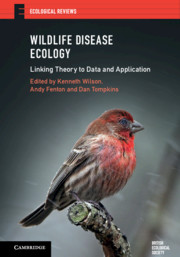Book contents
- Wildlife Disease Ecology
- Ecological Reviews
- Wildlife Disease Ecology
- Copyright page
- Contents
- Contributors
- Preface: Wildlife Disease Ecology
- Glossary of Terms
- Part I Understanding within-host processes
- Part II Understanding between-host processes
- Chapter Eight Using insect baculoviruses to understand how population structure affects disease spread
- Chapter Nine Infection and invasion: study cases from aquatic communities
- Chapter Ten Parasite-mediated selection in red grouse – consequences for population dynamics and mate choice
- Chapter Eleven Emergence, transmission and evolution of an uncommon enemy: Tasmanian devil facial tumour disease
- Chapter Twelve Bovine tuberculosis in badgers: sociality, infection and demography in a social mammal
- Chapter Thirteen Mycoplasma ovipneumoniae in bighorn sheep: from exploration to action
- Chapter Fourteen Manipulating parasites in an Arctic herbivore: gastrointestinal nematodes and the population regulation of Svalbard reindeer
- Part III Understanding wildlife disease ecology at the community and landscape level
- Index
- Plate Section (PDF Only)
- References
Chapter Fourteen - Manipulating parasites in an Arctic herbivore: gastrointestinal nematodes and the population regulation of Svalbard reindeer
from Part II - Understanding between-host processes
Published online by Cambridge University Press: 28 October 2019
- Wildlife Disease Ecology
- Ecological Reviews
- Wildlife Disease Ecology
- Copyright page
- Contents
- Contributors
- Preface: Wildlife Disease Ecology
- Glossary of Terms
- Part I Understanding within-host processes
- Part II Understanding between-host processes
- Chapter Eight Using insect baculoviruses to understand how population structure affects disease spread
- Chapter Nine Infection and invasion: study cases from aquatic communities
- Chapter Ten Parasite-mediated selection in red grouse – consequences for population dynamics and mate choice
- Chapter Eleven Emergence, transmission and evolution of an uncommon enemy: Tasmanian devil facial tumour disease
- Chapter Twelve Bovine tuberculosis in badgers: sociality, infection and demography in a social mammal
- Chapter Thirteen Mycoplasma ovipneumoniae in bighorn sheep: from exploration to action
- Chapter Fourteen Manipulating parasites in an Arctic herbivore: gastrointestinal nematodes and the population regulation of Svalbard reindeer
- Part III Understanding wildlife disease ecology at the community and landscape level
- Index
- Plate Section (PDF Only)
- References
Summary
The main drivers of Svalbard reindeer population dynamics are likely to be limited food resources, periods of harsh winter weather and their abundant parasitic nematode infections. To show parasite demographic impact requires three approaches: field observation to document life history and abundances of parasites/hosts; manipulation of infection to quantify the effect of parasite intensity on host fitness; appropriate population models of density-dependent transmission. We monitored the reindeer population and intensity of parasites in culled reindeer, and treated a randomly selected reindeer group with an anthelmintic, comparing their fitness with a control group. The two main nematode species differed in life histories. Ostertagia gruehneri infected reindeer over the summer. Marshallagia marshalli transmission was limited to the harsh arctic winter. This implies that our treatment only affected O. gruehneri and showed that reindeer fecundity depends on intensity of O. gruehneri infection, which varied between years and was positively related to host population size. Modelling this interaction suggested a role for O. gruehneri in reindeer population regulation. More experiments with a delayed anthelmintic treatment, designed to manipulate M. marshalli numbers over the winter, provided little evidence of this parasite’s impact on host population dynamics.
Keywords
- Type
- Chapter
- Information
- Wildlife Disease EcologyLinking Theory to Data and Application, pp. 397 - 426Publisher: Cambridge University PressPrint publication year: 2019
References
- 1
- Cited by



